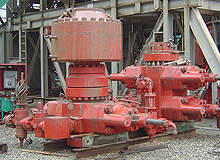
The postmortem into the Deepwater Horizon disaster in April 2010 has inevitably focused on the blowout preventer (BOP) and why it failed at the critical moment. But while the exact chain of events leading up to the disaster are still unclear, some experts have their suspicions as to the contributory factors.
According to Simon Goldfinch, an independent valve technology consultant, a key factor is the sheer depths involved in working on such a project.
“BOP systems are designed for shallow water and this marks the first time anyone has tried to adapt it for deepwater,” he says. “But working this deep is like trying to drill on the moon, and getting equipment to work reliably at this depth is incredibly hard.
“I don’t think anyone took into account how deep this well was, and no-one had tried and tested the equipment at such depth. We’re talking about 20,000psi down there, and I don’t think the equipment was designed for deepwater. Possibly unfair demands were made on the system on the seabed.”
Geoffrey Maitland, professor of energy engineering at the UK’s Imperial College London, has a contrasting view.
“I don’t believe the causes of the accident were particularly associated with deepwater,” he says. “It was the absence of ready, available and rapid solutions to sealing off an open gushing well in remote deepwater that was the major problem.”
How well do you really know your competitors?
Access the most comprehensive Company Profiles on the market, powered by GlobalData. Save hours of research. Gain competitive edge.

Thank you!
Your download email will arrive shortly
Not ready to buy yet? Download a free sample
We are confident about the unique quality of our Company Profiles. However, we want you to make the most beneficial decision for your business, so we offer a free sample that you can download by submitting the below form
By GlobalDataDeepwater drilling requirements
Control is another issue for Goldfinch: “International oil rigs are required to be equipped with an electronic device to shut down a blowout automatically. I’ve heard, though, that the US does not require this device, and consequently BP did not install one on the Horizon rig. It’s inconceivable that BP did not install the equipment that may have prevented this disaster, but even more so that the US Minerals Management Service does not require it on every rig licensed in US waters.”
This may prove to be a moot point, as Prof Maitland explains: “There may have been problems with the BOP control system and actuators, but the recent problems with removing the original BOP stack confirm that pieces of drillpipe were stuck inside the ram preventer valves. It’s possible that because there were several pipes – and / or the tool joints where sections of drillpipe are joined – inside the BOP, the shear rams were unable to cut the steel pipe and hence close. So, even if the BOP valves had been actuated, a mechanical problem of this sort may well have prevented the BOP system from shutting off the well during the initial blowout.”
Deepwater Horizon operator error?
He stresses the need to distinguish between the causes of the blowout in the first place and the failure of the BOP system to close and prevent the oil and gas reaching the rig floor once it was on its way.
“This well was not yet producing: it was just being drilled down to the reservoir,” he says. “The blowout occurred as the rig was being disconnected from the well prior to leaving it dormant for a while before being re-entered for production at a later date. The only issue relating to operations I can see is if modifications were made to decrease the number of false alarms that may lead to BOP closure and hence interrupt and delay the drilling operation.”
Goldfinch echoes this human factor, saying, “Some reports suggest the operators played around with the valve systems and piping in a way that was not in accordance with the operating instructions.”
Comprehensive blowout prevention
Ultimately though, says Maitland, whatever the contributory causes, a blowout of this sort can only be prevented if a significant number of safety measures are put in place in parallel to prevent oil and gas from the subsurface formation entering the well all fail at the same time.
“While the BOP failing to shut is a contributory and critical reason why the event became a disaster, lots of other things should have prevented the oil and gas entering the well in the first place – the cement seal [on the final casing string], the closed casing shoe and plugs, the heavy drilling fluid in the well and the riser exerting a hydrostatic pressure high enough to counter the natural oil and gas pressure as it entered,” he says.
In Goldfinch’s view, whatever the causes, the driving factor behind the disaster was one of economics. “It’s a symptom of the hunt for oil in deeper areas. Another Horizon is inevitable if the lessons aren’t learnt soon – and it’s the second deepwater disaster in a year,” he says, alluding to the Timor Sea spill in August 2009 where, he says, the BOP also failed. “Someone needs to put the brakes on the money people and say, ‘No, the technology needs to be tested or upgraded properly’.”



